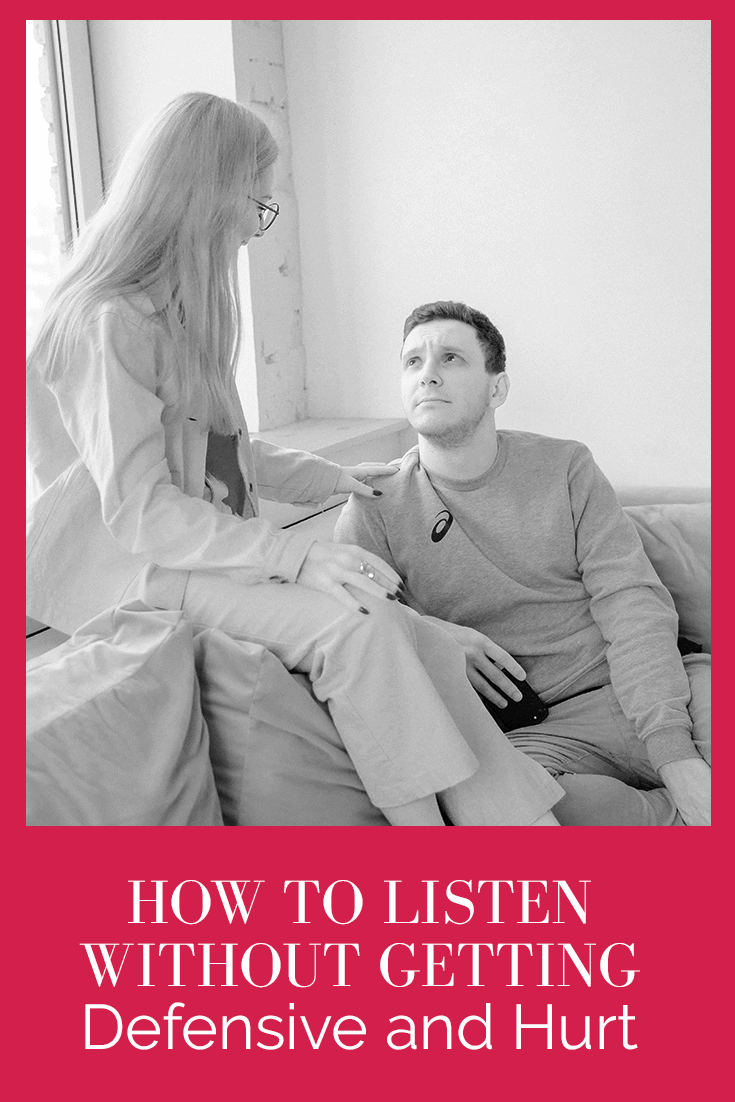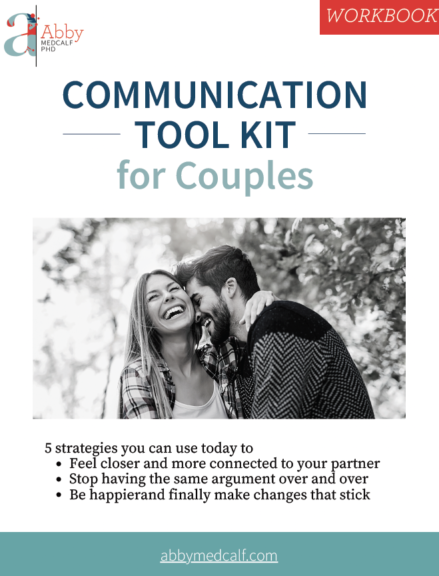
Can you listen to someone without getting defensive or hurt? It doesn’t matter if it’s your partner, friend or a work colleague — it’s so easy to get defensive and butt-hurt when they’re coming at you with something they’re upset about. When you get into a fear-based emotion yourself, you end up with a conversation that spirals down and you both walk away feeling misunderstood, unhappy and disconnected.
What’s the answer? You can listen without getting defensive or hurt and have a great outcome if you follow my quick and easy, seven step process.
You absolutely can have one of those difficult conversations and listen without getting defensive or hurt (or at least without allowing the hurt to ruin the dialogue). The biggest problem people have is that they’re not prepared correctly for the conversation.
Have you ever painted a room thinking it would be fun to paint? Ha! You don’t realize that there’s an actual right way to do it and you don’t prepare well or have the right tools and you end up with sloppy looking walls, paint drips, missed areas, and paint all over where it shouldn’t be?
Now, have you ever watched a professional painter paint a room? Do you know where they spend the most time? Preparing to paint! They sand the walls, fill in holes, tape corners and edges, tarp the floor and cover everything that shouldn’t get paint on it. The actual painting often takes equal or less time. But when they’re done it looks perfect.
This is how you have to think of listening without getting defensive or hurt. You need to put as much energy into the prep as you do to the actual conversation. Once you do that, it’s incredible how great (even easy) this can go!
The 7 Steps to Listening Without Getting Defensive or Hurt
Step 1: Be Ready
You’ve got to be in the right mental frame when you’re approaching the conversation. If you’re thinking things like, “It’s going to suck. It’s going to be really hard or difficult,” then that’s what you’re going to get. If you’re going in and you’re prepared to do battle, you’re going to end up hurt and defensive. You can’t have an open, connecting conversation if you’re approaching it like a war because you absolutely will both be on the defensive and you can’t have mutual understanding from that place: it’s impossible.
Step 2: Identify a Time and Place
Don’t have these conversations “on the run” or as a “by the way.” Set up a time and place that makes sense to have a connecting talk. Don’t have it at the very end of a long day because you’ll both be exhausted and it’s hard to find the mental reserves.
Try to be as fresh as possible and also be mindful of where you speak. Don’t whisper a tough conversation in the kitchen when everyone’s sitting in the dining room straining to hear!
If something starts off seeming like a small aside but becomes big, stop the talk immediately and get into set up mode or find another time to speak.
Step 3: Set Intention
State your intention out loud first (both parties, if possible). What’s your intention for this conversation?
- It’s my intention to listen with an open heart to everything you say.
- It’s my intention to think about how much I love you and how much I want to understand your point.
- It’s my intention that we’ll both walk away from this conversation feeling connected and heard.
- It’s my intention that we’re going to have an even better work relationship after this conversation.
- It’s my intention to bring willingness and thoughtfulness to the table.
- It’s my intention that we’ll find a mutually beneficial solution and both walk away satisfied/content/happy.
Setting intention puts everyone in the right frame of mind and will program the RAS to look for good things. It’ll help people stay focused and mindful during the conversation. It will often even change the approach and tone of the person sharing with you as they realize that what they were about to say or how they were about to say it wasn’t in line with the intentions you’re laying down!
You’ve got to connect to correct and stating your intentions helps everyone involved feel safer and more connected. If you do nothing else, do this step: it’s a game-changer!
Step 4: Be Curious
Actively think of being curious during this conversation. You really want to understand where the other person is coming from and why they feel the way they do. So, listen like you’re wrong and be in a mode of seeking to understand (as opposed to being understood).
Your inside voice should sound something like: “Wow! I really didn’t mean to upset this person. I wonder why they’re having this reaction? I need to figure that out. What’s really going on here?”
Remind yourself why you’re listening:
- It’s because you love and care about this person and want to find a resolution.
- It’s because you need to continue to work with this person and it’ll improve everything if you can find a way to hear what they’re saying so you can create solutions
Step 5: Stay Mindful During the Talk
Keep noticing your reactions. When you notice yourself getting defensive, hurt, or angry, bring yourself back to present. You’re going to have to really stay in touch with your feelings throughout the conversation. Notice your shoulders tensing up? Take a deep breath and push yourself to relax.
Name your own feelings as often as possible in this dialogue. This can even be part of the conversation; you can stop and ask “How are you feeling right now?” Or ask yourself, “What am I feeling right now?” If it’s a fear-based emotion such as resentment, hopelessness, or defensiveness, take a moment and bring yourself back to center. Have a mantra at the ready: “There’s nothing scary here. We’re going to work this out. There’s nothing for me to fear.”
As I mentioned, taking a deep breath is an excellent thing to do when you’re noticing any fear-based emotion emerging. You might notice impatience or frustration so you’ll take a deep breath which will stimulate your vagus nerve and help you stay calm and in the moment.
Be as mindful as possible as the other person speaks. Some marriage gurus talk about taking notes during the conversation, but that’s not my favorite way to start. Taking notes takes us out of the intimacy and connection of the moment. It also means that you’re missing so much of what the other person is saying and you’re not able to read their body language because your brain is somewhere else. You’re not going to come back point by point and tell them how wrong they are so why take notes?
Instead, do your best to stay present and remember that you’re focused on a loving outcome (or whatever your shared intention was). Keep coming back to that. “We will absolutely find a way through this and be there for one another.” “I’m going to be the dominant vibration with Sandra from Accounting and we’re going to come to a mutually beneficial arrangement about this.”
There is never a time in this conversation when you should:
- Interrupt
- Think about retaliatory remarks
- Keep score (well, what about you and what you did?)
- Deny the other person’s point of view (you misunderstood what I meant)!
- Refuse to participate (I’m tired of this topic, I’m not going to discuss this with you again!)
You’re not listening when you do any of these things and it’s a signal to reset yourself and be mindful.
Remember that it’s absolutely fine to stop the conversation or take a break if you’re noticing that you’re getting worked up, defensive or hurt and just can’t seem to stop feeling that way. Just be honest, “Your feelings are important but, right now, I’m noticing that I’m feeling defensive and taking things personally. Let’s take a break and come back in 30 minutes.” Make sure that when you come back that you re-state your intentions.
Step 6: Ask Clarifying Questions
At the beginning, or at some point during the conversation, ask that they give you a signal when they’re done so you can respond and ask questions. This will help you not interrupt and will ensure that the other person feels that you’re fully present in the conversation and giving them space and time to share. Don’t interrupt, unless it feels abusive. In that case, stop the conversation and re-set.
It’s important to remember that the other person’s complaint, comments or feedback is about what they need, not what you need. Listen for what they need, which isn’t always what they’re asking for. Asking clarifying, collaborative questions after they’re done speaking is the way to go.
You can clarify what the other person said, with the ever-popular (and effective): “What I heard you say is X.” You can also get more information by asking, “Can you tell me more about x?” “Can you give me an example of X so I better understand what you mean?”
Remember not to SAC. Ask questions meant to gather more information, not ones disguised as suggestions.
Step 7: Take Responsibility
No matter what is said to you, in whatever way, you still have responsibility in this relationship. I don’t care if Josh from sales is an asshole or if your wife’s best friend is a total jerk, you co-create every single relationship you’re in. This means, you have to take responsibility for your side of the street.
If you can’t find anything you can do or say to move things along then you’re not looking at your own issues. If you’re still feeling hurt and upset by this person, that’s your responsibility. Your feelings are your responsibility. Your boundaries are your responsibility. Your reactions are your responsibility.
This isn’t about blame! Do the one next thing you can and don’t give up and you’ll soon learn to listen without getting defensive or hurt on a regular basis!






